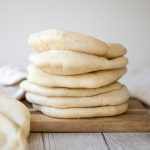Description
Nothing compares to freshly baked, quick and easy homemade pita bread. It's soft and puffy, with a perfect pocket. It takes just 15 minutes of actual prep.
Ingredients
- 500 grams all-purpose flour (3 + 1/2 cups)
- 5 grams instant yeast (1 + 1/2 teaspoons)
- 5 grams salt (1 teaspoon)
- 4 grams sugar (1 teaspoon)
- 330 grams water (1 + 1/3 cups)
- 25 grams olive oil (2 tablespoons)
Instructions
Prepare the Dough
- In a large bowl, whisk together flour, instant yeast, salt and sugar and mix evenly.
- Add water and olive oil. Mix well with a spatula to combine until a shaggy dough ball is formed. Make sure to scrape off any dry flour on the sides of the bowl.
Knead the Dough
- Transfer the dough onto a clean and dry surface. Apply a small amount of oil in your hands to prevent the dough from sticking. If the dough sticks to the work surface, use a bench scraper to clear it off.
- Knead the dough by pushing it down and outward using the palms of your hands. Fold the dough in half toward you and press down. Repeat this motion for 5 minutes by pushing the dough down and outward, and then folding over towards you. You can also pick up the dough and slap it down onto the counter and fold over towards you. (A kneading technique known as slap and fold).
- Cover the dough with a large bowl, upside down on top, and let it rest for 5 minutes. Resting allows gluten in dough to relax and further build more gluten strength. It’s very similar to how sleeping aids in muscle repair and new muscle growth in human body.
- Then knead the dough again for about 2-3 minutes until the dough ball is smooth and supple. It will be pliable and non-sticky. A well kneaded dough is smooth and can hold its shape. To check if the dough is well-kneaded, give the dough ball a firm poke with your finger. The indentation should bounce right back. If it doesn’t bounce back and stays like a dimple, knead for a few more minutes.
- Cover and let the dough rest in a large bowl for 1 hour or until it doubles in size. You can apply a little bit of oil on the surface of the dough ball to prevent it from losing moisture.
Shape and Divide the Dough
- Transfer dough onto a lightly floured surface. Roll the dough into a log and divide it into 10 equal pieces with a knife or bench scraper. Cover the dough with a damp cloth or cling wrap to prevent dough from drying. When the dough loses moisture, it tends to form hard skin around its surface, which creates a crust when baking.
- Take one piece at a time and shape each piece into a smooth ball. Flatten each dough, fold and press all edges into the centre. Turn it over and cup the dough in your palm, making circular motions. It should take less than 30 seconds to roll each piece into a smooth ball.
- Cover and let them rest for 30 minutes. The resting period helps the gluten in the dough relax and re-distributes air bubbles evenly inside the dough.
- Use a rolling pin to flatten each ball into a 6-inch circle (approximately). Sprinkle some flour if needed to prevent sticking. Set on a lightly floured surface, cover with a towel and let pitas rest for about 10 minutes.
Cook the Pitas
- There are two ways to cook the pitas. You can bake them in the oven or you can cook them in a pan on top of the stove.
- To bake in the oven: Preheat the baking tray inside the oven at 450 F. Bake the pitas (4 pitas at a time) for 5 minutes. Transfer to a wire cooling rack and repeat with remaining pitas.
- To cook on a pan: Brush some olive oil on a skillet and preheat on medium high heat for 3 minutes. Place one pita at a time onto the hot pan and cook for 3 minutes until the pita begins to puff up and the bottom has brown spots and blisters. Flip the pita and cook for 2 more minutes. Pita bread will begin to puff up on the other side too and fill with hot air. This is caused by the moisture inside the pita turning into steam from the heat.
- Transfer the pitas onto a wire cooling rack and allow them to cool down for 10 minutes.
Notes
Active dry yeast vs. instant yeast. You can substitute active dry yeast for instant yeast. If you use active dry yeast, then combine yeast, sugar and water first before adding flour and let it sit for 5 minutes to activate the dry yeast.
Well-kneaded dough. A well-kneaded dough should be smooth and bounces back quickly when poked with your finger. If the indentation doesn’t bounce back right away and stays like a dimple, continue kneading for a few more minutes.
The texture of the dough. With the olive oil present in this recipe, the dough should be a bit sticky in the beginning. After a few minutes of kneading, the dough will turn smooth and not sticky. By lightly oiling your hands when kneading, it will help keep the dough from sticking to your hands at first.
How to store pita bread. Store the pitas for up to 3 days in an airtight sealed zip-loc bag at room temperature to prevent them from drying out. You can also store them in the freezer for up to 3 months in an airtight bag.
- Prep Time: 15 minutes (+1 hour 40 minutes rise time + 10 minute cooling time)
- Cook Time: 5 minutes
- Category: Bread
- Method: Bake
- Cuisine: Greek
